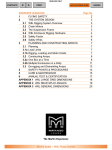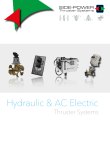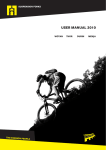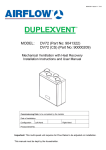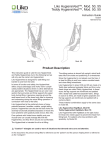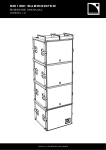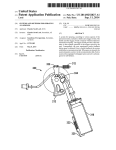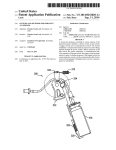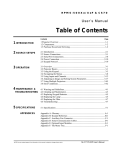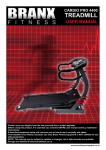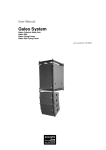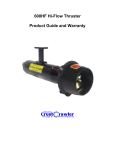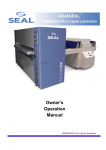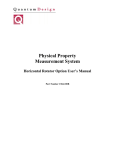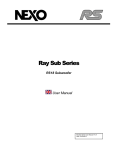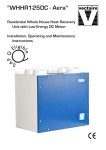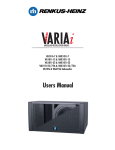Download W8L - Martin Audio
Transcript
ENGLISH ONLY CONTENTS < > PRINT APPLICATIONS GUIDE CONTENTS (ENGLISH) 1 FLYING SAFETY 2 THE SYSTEM DESIGN 2.1 W8L Rigging System Overview 2.2 Chain Motors 2.3 The Suspension Frame 2.4 W8L Enclosure Rigging Hardware 2.5 Safety Factor 2.6 Safety Wires 3 PLANNING AND CONSTRUCTING ARRAYS 3.1 Planning 3.1a Load Limits 3.1b Rigging, Loading and Motor Hoists 3.2 Constructing Arrays 3.2a One Box at a Time 3.2b Multiple Enclosures on a Dolly 3.3 De-rigging and Dismantling Arrays 4 SAFETY POINTS & PROCEDURES 5 CARE & MAINTENANCE 6 ANNUAL TEST & CERTIFICATION APPENDIX 1 W8L LARGE GRID DIMENSIONS APPENDIX 2 W8L REAR SPLAY ANGLES APPENDIX 3 W8L GENERAL DIMENSIONS APPENDIX 4 Suspension Grid 20-0003 APPENDIX 5 W8L/LD - Rigging dimensions and options MARTIN AUDIO L O N D O N The Martin Experience All material © 2007. Martin Audio Ltd. Subject to change without notice. Martin Audio – W8L Flying System Page No 2 3 3 3 3 4 6 6 7 7 7 7 8 8 11 13 14 15 17 18 19 20 GUIDES ENGLISH ONLY 1 > PRINT APPLICATIONS GUIDE FLYING SAFETY The prime concern in the design and use of loudspeaker flying systems is safety – the safety of the public, performers and all personnel who work with flying systems. Suspension of loudspeaker systems should only ever be undertaken by specialist, trained personnel working in association with professional riggers. Safety is crucially dependant on safe working practices, which must be learned, understood and adhered to. Everyone involved in the deployment of flown loudspeaker systems has a duty to safety. Different operating and safety requirements between and within countries make it impossible to give universally definitive advice on safety, so it is important that users consult with local regulatory authorities for specific guidelines. This manual is not the definitive guide to safe working practice in the use of flying systems but is advisory in nature and intended to promote safety by providing clear information on the capabilities, adjustment and safe use of the W8L flying system. Despite all the care taken in the design and manufacture of the flying system, Martin Audio Ltd. cannot guarantee complete safety whenever a flying system is used. Safety in use is dependent upon the safe working practices of flying system users. The advice and information contained in the manual does not absolve users from complying with any legal safety requirements and codes of practice in force at a time and place where a W8L system is deployed. Important! Everyone involved in the on-site assembly and deployment of a loudspeaker flying system has a duty to ensure the safe construction, adjustment and deployment of that flying system. It is therefore crucial that every W8L flying system user has the opportunity to read and fully understand the advice and information presented in this manual. Every W8L flying system user also needs to be properly trained in the safe use of the system before ever constructing and deploying the system in a working situation. 2 All material © 2007. Martin Audio Ltd. Subject to change without notice. Martin Audio – W8L Flying System GUIDES ENGLISH < CONTENTS ENGLISH ONLY 2 > PRINT APPLICATIONS GUIDE THE SYSTEM DESIGN The W8L suspension system allows arrays of loudspeaker cabinets to be vertically suspended or 'flown' from suitably secure and appropriately load rated rigging points in the roof structure of a theatre, hall or indoor arena. The W8L suspension system is rated with a safety factor of 7:1 and is solely and exclusively intended for use with the W8L loudspeaker enclosure. 2.1 W8L Rigging System Overview The rigging system consists of the following components: • A suspension frame (grid) from which a column of W8L’s is suspended. One frame per column is required. • Front and rear connecting mechanisms integral to the W8L cabinet. • Quick-release pins, captive in the cabinet. 2.2 Chain Motors A chain motor is an additional component used to lift the suspension system into position. A chain motor is specified by its maximum safe lifting capacity in US tons or metric Tonnes. For example, a 1 ton motor is capable of lifting 1 ton Note: 2.3 1 US ton = 2000lbs/907Kg 1 Tonne = 1000Kg/2205lbs The Suspension Frame (see appendix 1) The W8L suspension frame has two main pick-up points, one at the front and one at the rear. The line between the two points passes through the left/right centre of gravity of the array ensuring a straight hang when viewed from the front. The two pick-up points can each be attached to separate chain motors to distribute the load between the two points or allow the entire array to be tilted within certain limits. Alternatively, the two points can be attached to a single chain motor via a bridle if flown from a crane hook or when only a single overhead flying point is available. Additional points are provided either side of the main front and rear points, to permit alternative four-point bridle/motor configurations. 3 All material © 2007. Martin Audio Ltd. Subject to change without notice. Martin Audio – W8L Flying System GUIDES ENGLISH < CONTENTS ENGLISH ONLY < > PRINT APPLICATIONS GUIDE Both suspension frames are designed to fly an array of up to16 W8L enclosures with a 7:1 safety factor in a vertical hang. The table below shows the typical number of cabinets that can be flown using 1 and 2 ton motors with the large suspension frame weighing 130Kg (286lbs). These calculations do not necessarily allow for the points to act as a cable pick. Single Point (Bridle to crane hook) 1 x 1 ton Motor (up to 6 cabinets) Front and Rear Points (Two motors) 2 x 1 ton Motors* (up to 8 cabinets) 1 x 2 ton Motor (6 to 12 cabinets max) 2 x 2 ton Motors* (8 to 16 cabinets) *Note that the front to rear weight distribution becomes much more critical when the array is tilted. For example, if the array is tilted far enough so that all the load is borne by the rear point alone, then the maximum number of cabinets permitted would revert to the figure for a single point. WARNING! Careful calculations must always be made to ensure that all components are used well within their rated safe working load before the array is lifted. Never exceed the maximum load ratings marked on motors or suspension frames. Always raise and lower the load slowly and avoid rapid changes in load distribution that could result in a sudden jolt to the suspension components. 2.4 W8L Enclosure Rigging Hardware The W8L enclosure has steel rigging hardware at the front and rear of the enclosure. At either side of the front of the enclosure, a sliding tongue is stored within the front rigging assembly. Removal of a quick release pin allows the tongue to drop down into the front rigging assembly of the enclosure below, where it is secured using the same quick release pin. With this arrangement, the fronts of adjacent enclosures are hinged and securely locked together with only 5mm spacing between them. At either side of the rear of the enclosure, there is a channel housing a steel splay arm, used to set the splay angle between enclosures. In transit, the splay arm is held in place by a spring loaded catch. When released from its transit position swing the arm up into the channel of the enclosure above and fix at the required splay angle by the insertion of a quick release pin. This pin is stored at the rear of the enclosure during transit. 4 All material © 2007. Martin Audio Ltd. Subject to change without notice. Martin Audio – W8L Flying System GUIDES ENGLISH CONTENTS ENGLISH ONLY < > PRINT APPLICATIONS GUIDE Each rear channel has two sets of holes marked 0°, 1°, 2°, 3°, 4.5° and one set marked 6° and 7.5°. The splay arm incorporates both a hole and a slot to facilitate several different flying methods described in the following sections. (See appendix 2) WARNING! Prior to use, inspect all components of the array, including the chain hoists, suspension frames, enclosure, its front and rear rigging assemblies and pins etc. for damage, cracks, deformations, broken welds, corrosion or missing parts that could affect the strength and safety of the array. The load bearing capabilities of the building or support structure should always be assessed, inspected and certified by an appropriate professional engineer. 5 All material © 2007. Martin Audio Ltd. Subject to change without notice. Martin Audio – W8L Flying System GUIDES ENGLISH CONTENTS ENGLISH ONLY < 2.5 > PRINT APPLICATIONS GUIDE Safety Factor The W8L suspension system will only perform as designed when all four connection points are utilised. However, the W8L 7:1 safety factor is based on a worst-case scenario, where only two suspension points are supporting the enclosures below them. This could occur in tilted arrays where the load is shifted forward or back. The 7:1 safety factor will be maintained for up to a maximum of 16 boxes in the array, within certain limits of tilt. The W8L suspension spreadsheet program can be used to determine the limit of tilt for various array configurations. 2.6 Safety Wires Although the flying system is conservatively load rated, for maximum safety, an additional secondary rigging point should always be provided and used. Suspension points on the suspension frame that are not being used (side to side points NOT diagonal) for the chain motors may be used to attach safety bridles to a suitable, secure overhead rigging point, structurally independent of the main hanging point for the system. It is recommended that the safety bridles remain permanently attached to the frame as a reminder that they must be used. Note! The practice of crossing one safety bridle to an adjacent load hoist is not recommended, in the event of a motor or system failure this would cause a violent rotating action that would induce shock loads in directions the system is not designed to cope with. 6 All material © 2007. Martin Audio Ltd. Subject to change without notice. Martin Audio – W8L Flying System GUIDES ENGLISH CONTENTS ENGLISH ONLY 3 3.1 > PRINT APPLICATIONS GUIDE PLANNING AND CONSTRUCTING ARRAYS Planning A site survey should be conducted before arriving on site and a rigging plan prepared. The rigging plan should include details of the number and type of cabinets to be flown, their position in the array as well as the angles needed to best cover the audience areas of the venue. The plan should also include the weight, intended height and position of the load(s) to allow the venue riggers to select the rigging points needed to suspend the flying system from the roof of the building. 3.1a Load limits To maintain the 7:1 safety factor of the flying system, the above hook rigging - roof structure, rigging and motor chain hoists - should all be capable of supporting loads 7 times that of a fully loaded flying system. 3.1b Rigging, loading and motor hoists The rigging plan allows users to determine the exact position of the rigging points needed for the array described. The chains or steels suspended from the rigging points should hang vertically with the array attached - if they do not, then the horizontal shearing forces introduced by misalignment will reduce the load safety margin of the flying system. Because of this factor, users must ensure the correct position and spacing of the rigging points. But the most obvious result of mispositioning will be that the whole system will not array in the intended manner. Normally, a W8L system is flown from two separate rigging points. However a bridle chain can be used to fly a system from a single rigging point or crane hook. For bridled, single point suspension the load ratings of the motor hoist above hook rigging and the rigging point will all need to be double that used for normal twin point suspension. To ensure that the rated load safety factor of the W8L flying system is maintained, always check the actual total load of the flying system, rigging and loudspeaker cabinets. In calculating the total load on each rigging point remember to include the weight of the motor, cables and any additional rigging. Always consult the W8L data sheets for cabinet weights. See Section 2.3 for more information 7 All material © 2007. Martin Audio Ltd. Subject to change without notice. Martin Audio – W8L Flying System GUIDES ENGLISH < CONTENTS ENGLISH ONLY 3.2 > PRINT GUIDES APPLICATIONS GUIDE Constructing an Array Assembly and deployment of a flying system array is carried out using one of the following methods. 3.2a One Box at a Time With this method, after attaching the suspension frame to the first box, each box is rolled up to the rear of the frame on its wheelboard and attached one at a time, first attaching the rear points. The front of the cabinet is physically swung up and the front points attached. The wheelboard is then removed. The process is then repeated for the next box. Step 1 & 2 Step 1a & 2a Step 3 & 4 Step 5 Step 6 Using one motor, bridled (if using two motors, go to Step 1a below) Step 1 Attach the chain motor bridle to the suspension frame and raise the frame so that it is approximately 2.5 metres from the ground and horizontal. Caution should be exercised by personnel near the unloaded frame as it will tilt to one side because its own centre of gravity is not on the same line as the pick-up points. Step 2 Roll the first box under the frame, flip it over onto its runners (skids), manoeuvre it into position under the frame and remove its wheelboard. Remove the pins at the front of the frame which secure its captive tongues. Lower the frame onto the top box, locating the front tongues within the front rigging assembly. Secure the tongues in position with the quick release pin. Note that a pin is locked when its central button is out. 8 All material © 2007. Martin Audio Ltd. Subject to change without notice. Martin Audio – W8L Flying System ENGLISH < CONTENTS ENGLISH ONLY < > PRINT APPLICATIONS GUIDE Spring out each of the rear splay arms from its transit position and swing it up into the receptor at the rear of the frame. Secure it in the 0° position by inserting the quick release pin stored at the rear of the enclosure into the hole in the arm. Using front and rear motors Step 1a Position the frame upright with its front on the floor. Attach the chain motors to the suspension frame. Step 2a Roll the first box up to the frame. Remove the pins at the front of the frame which secure its captive front tongues and locate the front tongues within the front rigging assembly of the box . Secure the tongues in position with the quick release pin. Note that a pin is locked when its central button is out. Spring out each of the rear splay arms from its transit position and swing it up into the receptor at the rear of the frame. Secure it in the 0° position by inserting the quick release pin stored at the rear of the enclosure into the hole in the arm. Step 3 Gradually lift the frame using the motor(s) so that the lower rear corner of the lifted box is approximately 1m above the floor. Remove its wheelboard 9 All material © 2007. Martin Audio Ltd. Subject to change without notice. Martin Audio – W8L Flying System GUIDES ENGLISH CONTENTS ENGLISH ONLY < > PRINT APPLICATIONS GUIDE Step 4 Roll the next box into position on its wheelboard and lower the frame to align rear of the flown box with the box on the ground. Remove the quick release pins from their storage locations and spring out the rear splay arms. Secure each arm in place in the rear channel of the enclosure above by inserting a quick release pin into the hole position corresponding to the cabinet splay angle required. Safety Note: Use great care when handling quick release pins, front tongues and rear splay arms. Never, in any circumstances, insert a finger or hand into the slot in the rear splay arm. Never insert fingers or hands between boxes when chain hoists are moving. Step 5 Lift the frame to a convenient height. Step 6 Remove the pins at the front of the fully suspended box to release its captive tongues. Physically lift the front of the hanging enclosure and locate the front tongues within its front rigging assembly. Secure the tongues in position with the quick release pins and remove the wheelboard. Caution! The weight of the cabinet when lifting should be borne by at least three people – one either side and one at the front. 10 All material © 2007. Martin Audio Ltd. Subject to change without notice. Martin Audio – W8L Flying System GUIDES ENGLISH CONTENTS ENGLISH ONLY < > PRINT APPLICATIONS GUIDE Step 7 Repeat Steps 3-6 Safety Check As the array is lifted, make a visual and physical check to make sure that all the quick release pins are in their correct locations and secure. The pins are locked when their central buttons are out. Check that the splay angles are the same on both sides of each enclosure. 3.2b Multiple Enclosures on a Dolly With this method, the boxes are transported on a 3 or 4 box dolly, with the sliding front tongues between each cabinet already connected. Step 1 Attach the chain motors to the suspension frame and raise the frame to a height sufficient to clear the dolly. Caution should be exercised by personnel near the unloaded frame as it will tilt to one side because its own centre of gravity is not on the same line as the pick-up points. Step 2 Pre-rig the splay angles of the lower enclosures off-load by releasing the rear splay arm and swinging it up into the rear channel of the enclosure above. Remove a quick release pin from its storage position at the rear of the enclosure and insert it through the appropriate marked channel hole and through the slot in the splay arm. Note that a pin is locked when its central button is out. 11 All material © 2007. Martin Audio Ltd. Subject to change without notice. Martin Audio – W8L Flying System GUIDES ENGLISH CONTENTS ENGLISH ONLY < > PRINT APPLICATIONS GUIDE Roll the dolly into position beneath the suspension frame. Remove the pins at the front of the frame which secure its captive tongues. Lower the frame onto the top box, locating the front tongues within the front rigging assembly. Secure the tongues in position with the quick release pin. Release the rear splay arms of the top box and attach them to the rear receivers in the suspension frame using the quick release pins stored at the rear of the top enclosure. Safety Note Use great care when handling quick release pins, front tongues and rear splay arms. Never, in any circumstances, insert a finger or hand into the slot in the rear splay arm. Never insert fingers or hands between boxes when chain hoists are moving. Step 3 Slowly raise the suspension frame using the chain motor. As it lifts, the slots in the splay arms will slide on the quick release pins until they achieve the pre-set splay angle. At this point, a second quick release pin (supplied with the dolly) may be inserted in the rear channels to rigidise the array if required. Note that the second pin is optional and intended to prevent the rear of the array from collapsing upwards under a high degree of tilt or when a separate pull-up under-frame is used. Step 4 Remove the pins securing the bottom box to the dolly and lift the block of boxes off the dolly. Safety Check As the array is lifted off the dolly, make sure that all the quick release pins are in their correct locations and secure. The pins are locked when their central buttons are out. Check that the splay angles are the same on both sides of each enclosure. Step 5 Wheel the dolly out of the way and then roll another dolly beneath the array. Pre-rig the splay angles of the lower boxes on the dolly as in Step 2. 12 All material © 2007. Martin Audio Ltd. Subject to change without notice. Martin Audio – W8L Flying System GUIDES ENGLISH CONTENTS ENGLISH ONLY < > PRINT APPLICATIONS GUIDE Step 6 Remove the pins at the front of the lowest suspended box to release its captive tongues. Land the suspended array on top of the dolly, locating the front tongues within the front rigging assembly of the topmost box on the dolly. Secure the tongues in position with the quick release pin. Release the rear splay arms of the topmost box on the dolly and attach them to the rear of the box above, selecting the desired splay angle by inserting the quick release pins stored at the rear of the enclosure into the selected holes in the rear channel. Note: When landing the suspended array on the next dolly, great care must be taken with motor control. This is important to ensure that the entire weight of the suspended array is not borne by the lowest cabinet, the dolly itself or transferred through the dolly to the staging – none of which may be able to bear the weight of the entire array. Step 7 Repeat Steps 3 to 6. 3.3 De-rigging and Dismantling the Array. De-rigging and dismantling the array is essentially a reversal of the procedure followed to construct and fly the system and the same precautions and safety measures apply. The safety wires to the roof structure are first of all released. No one should be present in the area beneath the array whilst it is lowered in an even, smooth and controlled fashion. One box at a Time If the lowest boxes in the array are pinned in the tight 7.5° position, releasing the front tongues will not allow the front to swing down, as the boxes will bind at the rear. The rear splay angles will first need to be reduced by supporting the weight of the box at the rear and re-pinning at a smaller angle. Only when this has been done can the front tongues be released and the front of the box swung down. Multiple Enclosures on a Dolly When landing the suspended array on a dolly, great care must be taken with motor control. This is important to ensure that the entire weight of the suspended array is not borne by the lowest cabinet, the dolly itself or transferred through the dolly to the staging – none of which may be able to bear the weight of the entire array. 13 All material © 2007. Martin Audio Ltd. Subject to change without notice. Martin Audio – W8L Flying System GUIDES ENGLISH CONTENTS ENGLISH ONLY 4 > PRINT APPLICATIONS GUIDE SAFETY POINTS & PROCEDURES (1). To ensure safety, the rigging of loudspeaker flying systems in public or working areas should only be undertaken by specialists, contractors, venue or touring crew personnel with established, proven expertise as riggers and who have read this manual. Personnel assembling a system on site have a duty to ensure the safe construction, adjustment and deployment of the system. Before use all the system components must be subjected to careful and rigorous inspection and any component or assembly which has been misused or damaged must be immediately rejected and replaced. If there is any doubt whatsoever about the safety and integrity of the system, then it must not be deployed. (2). The safety of the system is affected by its operating environment. If for instance, a flying system is deployed out-of-doors during heavy rain, high winds or storms then inevitably, safety will be compromised. (3). All adjustments to the system must always be carried out only by hand - no levers, hammers, mechanical implements or other aids should be used to apply additional force. (4). All mechanical systems, flying systems included, eventually wear out. The way the system is used, lack of maintenance, exposure to water or corrosive agents, deformation or damage through improper storage or transport will all accelerate the process of deterioration and reduce the safety of the system. Owners and users of the flying system must take all practical steps to protect the system from deterioration. (5). The most important rule to follow when constructing and deploying the system is to check, check and check again. Never assume or take anything for granted - the most experienced and competent system riggers can (and sometimes do) make mistakes so always check your own work and that of the person next to you. (6). It helps in the case of larger arrays to have a work platform of sufficient height available in order to avoid having someone clamber over the swaying array to carry out adjustments. Please note that it is not possible to adjust/or remove quick release pins with the array suspended in the air - the array must be lowered to the ground. (7) Before flying the system, particularly with large arrays, it can save time and frustration later on to have a crew member temporarily wire up the controller racks and provide a test signal to check the speaker wiring when the check is complete, be sure to disconnect the loudspeakers at the racks before raising the system. 14 All material © 2007. Martin Audio Ltd. Subject to change without notice. Martin Audio – W8L Flying System GUIDES ENGLISH < CONTENTS ENGLISH ONLY > PRINT APPLICATIONS GUIDE (8). During the set-up operation and especially during all lifting operations the safety of the work crew should be paramount. Site safety rules must be clearly understood and observed by all. One competent, experienced person should be in charge of operating the hoists and should issue a clear loud warningand be satisfied that everyone is clear of the load before operating the hoists. For their safety, all site personnel not engaged in setting up the array should be kept clear of the working area. As the chain hoists operate, there is absolutely no need for anyone to be in the area directly beneath the array or in the near vicinity of that space. 5 CARE & MAINTENANCE All mechanical systems with moving parts are subject to wear and tear and the W8L flying system is no exception to this rule. Damage to the system components from long term wear and tear, accident, or the application of excessive force during set-up or adjustment can all increase the risk of mishaps. The W8L flying system is a safety-critical mechanical assembly so is vitally important that users adhere to a strictly enforced and documented regime of inspection and preventative maintenance. All those who set-up and use the system must be fully informed of safety inspection procedures and their responsibility for their implementation. The following information and advice is intended to promote the safety and well-being of everyone: equipment owners, users, performers and of course, the public. The principal flying system components are all finished in a black powder coat finish. Under normal conditions of use, this finish will, unless damaged, protect the main components against rusting and corrosion. However, it should be clearly noted that any exposure to water, rain, or corrosive chemicals during transport or use could weaken elements of the system. At greatest risk from rust and corrosion are the moving parts used to connect or join the enclosures. Frequent, thorough inspection for evidence of corrosion is absolutely essential - as is the application of a moisture displacing treatment such as WD40 on exposed bare metal parts. As a general rule, the system should be subjected to close visual inspection every time it is unpacked or packed. To provide a cross-check, the inspection should be carried out by more than one person. For record purposes and as an aid to consistency, a log book with a printed check list of inspection steps should be packed with the system so that users can check off each element of the inspection procedure as they carry it out. The log book should also register the details of the system such as a full parts inventory, the serial or unique numbers stamped or engraved on the parts, a comment section for users, details of where and when the system has been used for shows with references to the venue rigging plan and system details. 15 All material © 2007. Martin Audio Ltd. Subject to change without notice. Martin Audio – W8L Flying System GUIDES ENGLISH < CONTENTS ENGLISH ONLY < > PRINT APPLICATIONS GUIDE A copy of the Declaration of Conformity, supplied with the system or evidence (such as a Certificate of Examination) that a thorough examination has been carried out by a competent person should be kept with the log book. No system should ever be deployed without being accompanied by either of these documents. After prolonged touring use, flying systems should be removed and carefully inspected. During inspection between tours, the system should preferably be set up and suspended as if it were about to be used. All moving parts should be examined for free movement, looseness, or signs of wear on adjacent or mating surfaces. All quick release pins should move freely and operate correctly, again checking for signs of deformation or undue wear. On releasing the rear splay arm, the arm should disengage and rotate easily and positively lock into place when re set. The sliding tongue at the front of the enclosure should move freely and be examined for signs of deformation or undue wear. A close visual inspection should be made of the entire surface of the bars points to look out for are any signs of buckling, twisting or other deformation. The surface and the weld seams of the bars should also be clean and show no signs of corrosion or erosion and the manufacturers labels and engraved marks should not have been tampered with. Needless-to-say, if any defects are discovered during inspection which cast doubt on the safety of the flying system it should not be deployed. Flying systems set up in permanent installations pose fewer safety problems than touring or mobile systems. None-the-less, regular safety inspections of fixed or semi-fixed systems based upon the above guidance should also be undertaken. 16 All material © 2007. Martin Audio Ltd. Subject to change without notice. Martin Audio – W8L Flying System GUIDES ENGLISH CONTENTS ENGLISH ONLY 6 > PRINT APPLICATIONS GUIDE BI ANNUAL TEST AND CERTIFICATION Every Martin Audio W8L flying system is initially supplied with a CE Declaration of Conformity. In the UK, after a period of one year from the date of issue, the system will need to be thoroughly inspected by a competent person and a report/Certificate of Examination issued in accordance with LOLER (Lifting Operations and Lifting Equipment Regulations 1998). This inspection process will then need to be undertaken every six months. Note: LOLER is a UK regulation. Health and Safety regulations covering the inspection of lifting equipment may exist in other countries. Since no flying system should ever be deployed unless covered initially by the manufacturers Declaration of Conformity and subsequently by a valid Certificate of Examination, the Certificate of Examination will need to be renewed bi-annually. In addition to the regular care & maintenance regime detailed above, every W8L flying system should ideally be submitted once a year to an independent test organisation for inspection and re-certification. If necessary the proof load test procedure outlined below should only be carried out by an experienced test engineer, qualified and accredited to inspect, test and issue safety certificates for mechanical lifting equipment. The test applies only to the W8L Grid assembly. (Contact supplier for more information). The serial number, date of manufacture and safe working load of the bar are all detailed on the identity plate. No proof load test should be carried out on any flying bar presented as part of a W8L flying system which does not carry the manufacturers identity plate. No proof load test should be carried out on any flying bar presented as part of a W8L flying system were the details on the attached manufacturers identity plate have been defaced or altered. 17 All material © 2007. Martin Audio Ltd. Subject to change without notice. Martin Audio – W8L Flying System GUIDES ENGLISH < CONTENTS ENGLISH ONLY < > APPENDIX 1 PRINT APPLICATIONS GUIDE W8L LARGE GRID DIMENSIONS 18 All material © 2007. Martin Audio Ltd. Subject to change without notice. Martin Audio – W8L Flying System GUIDES ENGLISH CONTENTS ENGLISH ONLY < > APPENDIX 2 PRINT APPLICATIONS GUIDE W8L REAR SPAY ANGLES 19 All material © 2007. Martin Audio Ltd. Subject to change without notice. Martin Audio – W8L Flying System GUIDES ENGLISH CONTENTS ENGLISH ONLY < > APPENDIX 3 PRINT APPLICATIONS GUIDE W8L GENERAL DIMENSIONS General information W8L Flying System User Manual Version 1.05, May 2002 Copyright by Martin Audio Ltd 2002; all rights reserved. The information presented in this document is, to the best of our knowledge, correct. We will however not be held responsible for the consequences of any errors or omissions. Technical specifications, weights and dimensions should always be confirmed with Martin Audio before inclusion in any additional documentation. In our efforts to develop and improve our products we reserve the right to change the technical specification of our products without notice. Martin Audio tries, whenever possible, to minimise the effects of product changes on equipment compatibility. Martin Audio Ltd, Century Point, Halifax Road, Cressex Business Park, High Wycombe, Buckinghamshire. UK. Tel: +44 (0)1494 535312 Fax: +44 (0)1494 438669 email: [email protected] web: www.martin-audio.com 20 All material © 2007. Martin Audio Ltd. Subject to change without notice. Martin Audio – W8L Flying System GUIDES ENGLISH CONTENTS W8L Flying System User Manual - Appendix 4 Suspension Grid 20-0003 Suspension Grid 20-0003 is smaller and lighter than the large grid shown in Appendix 1 of the W8L Flying System User Manual. The main difference is that the 20-0003 grid is designed to connect to the chain motors via front and rear bridles (supplied with the grid). Two chain motors, one front and one rear are required to lift and tilt the grid/array. The bridles are asymmetrical so that the C of G of the system always lies below the motors. Please note that the grid is only designed for fore-and-aft lifting. Under no circumstances remove or reconfigure the bridles and attempt to lift the grid with motors at either side of the array. IMPORTANT WARNING! DO NOT REMOVE OR RECONFIGURE THE BRIDLES. THE GRID IS ONLY DESIGNED FOR FORE-AND-AFT LIFTING USING THE BRIDLES AS SUPPLIED DO NOT ATTEMPT TO LIFT THE GRID USING SIDE-BY-SIDE MOTORS. THIS COULD RESULT IN UNEVEN LIFTING, CAUSING DANGEROUS TORTIONAL STRESSES TO BE TRANSMITTED THROUGH THE ENCLOSURE. All material © 2007. Martin Audio Ltd. Subject to change without notice. The grid is designed to fly an array of up to 16 W8L enclosures with a 7:1 safety factor. The typical number of cabinets that can be flown using 1 and 2 ton motors with the 200003 frame weighing 94Kg (207lbs) are shown below. Note that these calculations do not necessarily allow for the points to act as a cable pick. Single Point (Bridles to crane hook) Front and Rear Points (Two motors) 1 x 1 ton Motor: up to 6 cabinets 2 x 1 ton Motor*: up to 8 cabinets 1 x 2 ton Motor: 6 to 12 cabinets max 2 x 2 ton Motors*: 8 to 16 cabinets * Note that the front to rear weight distribution becomes much more critical when the array is tilted. For example, if the array is tilted far enough so that all the load is borne by the rear point alone, then the maximum number of cabinets permitted would revert to the figure for a single point. SAFETY WIRES Although the flying system is conservatively load rated, for maximum safety, an additional secondary rigging point should always be provided and used. Suspension points on the suspension frame that are not being used (side to side points NOT diagonal) for the chain motors may be used to attach separate safety wires to suitable, secure overhead rigging points, structurally independent of the main hanging point for the system. If these safety wires have to be bridled to attach to a single point in the building structure, make sure that the individual legs of the bridle are as long as possible as a short bridle will transmit high lateral forces to the grid in the event of a motor or system failure. Note! The practice of crossing one safety bridle to an adjacent load hoist is not recommended, in the event of a motor or system failure this would induce a violent rotating action that would induce shock loads in directions the system is not designed to cope with. All material © 2007. Martin Audio Ltd. Subject to change without notice. All material © 2007. Martin Audio Ltd. Subject to change without notice. ENGLISH ONLY CONTENTS < > PRINT APPLICATIONS GUIDE W8L Flying System Please Click here to return to main menu Please Click here to visit our website MARTIN AUDIO L O N D O N The Martin Experience Century Point, Halifax Road, Cressex Business Park, High Wycombe, Buckinghamshire HP12 3SL, England. Telephone: +44 (0)1494 535312 Facsimile: +44 (0)1494 438669 Web: www.martin-audio.com E-mail: [email protected] All material © 2007. Martin Audio Ltd. Subject to change without notice. GUIDES ENGLISH ONLY CONTENTS < > PRINT APPLICATIONS GUIDE W8L Flying System User’s Guide ENGLISH MARTIN AUDIO L O N D O N The Martin Experience All material © 2007. Martin Audio Ltd. Subject to change without notice. GUIDES

























